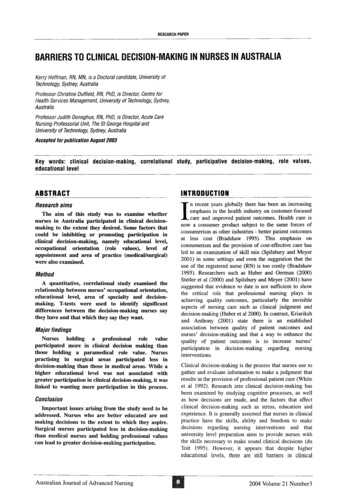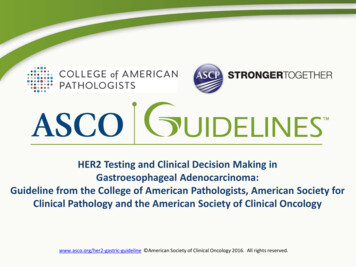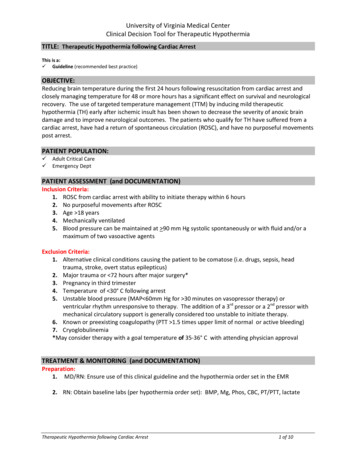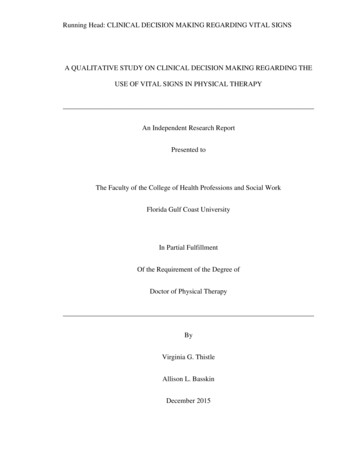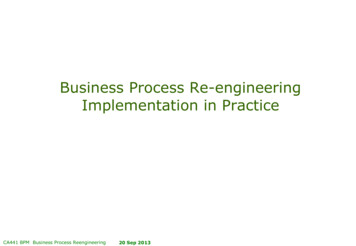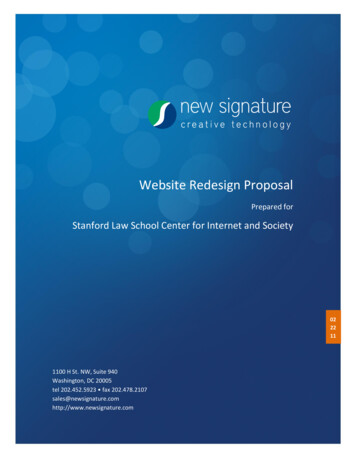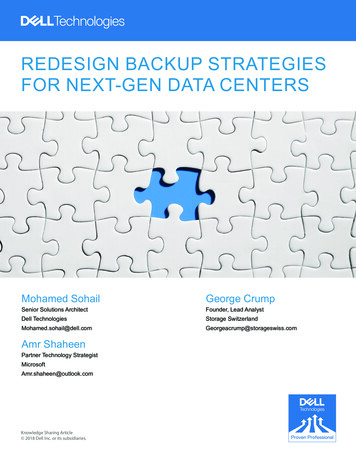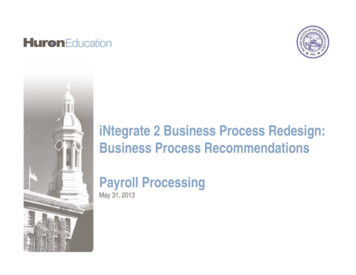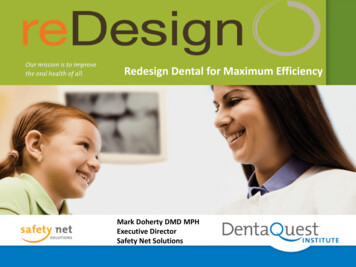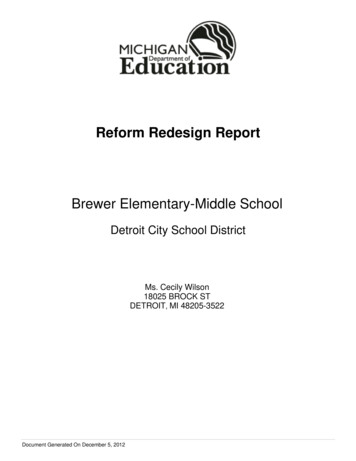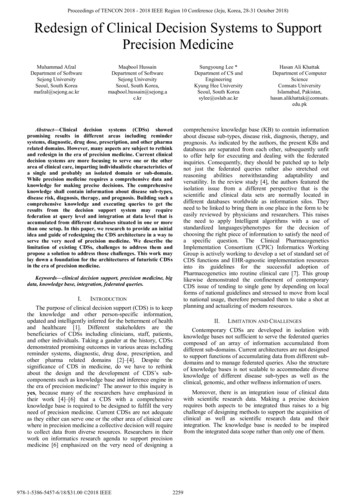
Transcription
Proceedings of TENCON 2018 - 2018 IEEE Region 10 Conference (Jeju, Korea, 28-31 October 2018)Redesign of Clinical Decision Systems to SupportPrecision MedicineMuhammad AfzalDepartment of SoftwareSejong UniversitySeoul, South Koreamafzal@sejong.ac.krMaqbool HussainDepartment of SoftwareSejong UniversitySeoul, South Korea,maqbool.hussain@sejong.ac.krSungyoung Lee *Department of CS andEngineeringKyung Hee UniversitySeoul, South Koreasylee@oslab.ac.krAbstract—Clinical decision systems (CDSs) showedpromising results in different areas including remindersystems, diagnostic, drug dose, prescription, and other pharmarelated domains. However, many aspects are subject to rethinkand redesign in the era of precision medicine. Current clinicaldecision systems are more focusing to serve one or the otherarea of clinical care, imparting individualistic characteristics ofa single and probably an isolated domain or sub-domain.While precision medicine requires a comprehensive data andknowledge for making precise decisions. The comprehensiveknowledge shall contain information about disease sub-types,disease risk, diagnosis, therapy, and prognosis. Building such acomprehensive knowledge and executing queries to get theresults from the decision support system may requirefederation at query level and integration at data level that isaccumulated from different databases situated in one or morethan one setup. In this paper, we research to provide an initialidea and guide of redesigning the CDS architecture in a way toserve the very need of precision medicine. We describe thelimitation of existing CDSs, challenges to address them andpropose a solution to address those challenges. This work maylay down a foundation for the architectures of futuristic CDSsin the era of precision medicine.Keywords—clinical decision support, precision medicine, bigdata, knowledge base, integration, federated queries.I.INTRODUCTIONThe purpose of clinical decision support (CDS) is to keepthe knowledge and other person-specific information,updated and intelligently inferred for the betterment of healthand healthcare [1]. Different stakeholders are thebeneficiaries of CDSs including clinicians, staff, patients,and other individuals. Taking a gander at the history, CDSsdemonstrated promising outcomes in various areas includingreminder systems, diagnostic, drug dose, prescription, andother pharma related domains [2]–[4]. Despite thesignificance of CDS in medicine, do we have to rethinkabout the design and the development of CDS’s subcomponents such as knowledge base and inference engine inthe era of precision medicine? The answer to this inquiry isyes, because many of the researchers have emphasized intheir work [4]–[6] that a CDS with a comprehensiveknowledge base is required to be designed to fulfill the veryneed of precision medicine. Current CDSs are not adequateas they either can serve one or the other area of clinical carewhere in precision medicine a collective decision will requireto collect data from diverse resources. Researchers in theirwork on informatics research agenda to support precisionmedicine [6] emphasized on the very need of designing a978-1-5386-5457-6/18/ 31.00 2018 IEEEHasan Ali KhattakDepartment of ComputerScienceComsats UniversityIslamabad, ive knowledge base (KB) to contain informationabout disease sub-types, disease risk, diagnosis, therapy, andprognosis. As indicated by the authors, the present KBs anddatabases are separated from each other, subsequently unfitto offer help for executing and dealing with the federatedinquiries. Consequently, they should be patched up to helpnot just the federated queries rather also stretched outreasoning abilities notwithstanding adaptability andversatility. In the review study [4], the authors featured theisolation issue from a different perspective that is thescientific and clinical data sets are normally located indifferent databases worldwide as information silos. Theyneed to be linked to bring them in one place in the form to beeasily reviewed by physicians and researchers. This raisesthe need to apply Intelligent algorithms with a use ofstandardized languages/phenotypes for the decision ofchoosing the right piece of information to satisfy the need ofa specific question. The Clinical PharmacogeneticsImplementation Consortium (CPIC) Informatics WorkingGroup is actively working to develop a set of standard set ofCDS functions and EHR-agnostic implementation resourcesinto its guidelines for the successful adoption ofPharmacogenetics into routine clinical care [7]. This grouplikewise demonstrated the confinement of contemporaryCDS issue of tending to single gene by depending on localforms of national guidelines and stressed to move from localto national usage, therefore persuaded them to take a shot atplanning and actualizing of modern resources.II.LIMITATION AND CHALLENGESContemporary CDSs are developed in isolation withknowledge bases not sufficient to serve the federated queriescomposed of an array of information accumulated fromdifferent sub-domains. Current architectures are not designedto support functions of accumulating data from different subdomains and to manage federated queries. Also the structureof knowledge bases is not scalable to accommodate diverseknowledge of different disease sub-types as well as theclinical, genomic, and other wellness information of users.Moreover, there is an integration issue of clinical datawith scientific research data. Making a precise decisionrequires both aspects to be integrated thus raises to a bigchallenge of designing methods to support the acquisition ofclinical as well as scientific research data and theirintegration. The knowledge base is needed to be inspiredfrom the integrated data scope rather than only one of them.2259
Proceedings of TENCON 2018 - 2018 IEEE Region 10 Conference (Jeju, Korea, 28-31 October 2018)Figure 1: Proposed architecture of clinical decision systemIII.computationally expensive and time taking activity.Today, however, with the advent of advancedtechnology, genomic data could be used alongsideclinical data to precisely diagnose and treat differentsub-types of diseases such as cancer and others. Thisdata itself renders a set of challenges to acquire, suchas designing of a database to hold voluminous dataand controlling the variability of the data and soforth [10].PROPOSED SOLUTIONBased on the initial investigation, we come up with anarchitecture as depicted in Figure 1 to combine differentcomponents required by the next generation CDS. Thearchitecture abstractly describes the modules containing therequired functions of envisioned CDS’s architecture formaking precise decisions. We here introduce and explain thedetails of each of these modules for a better understanding ofthe proposed idea. A. Health Data AcquisitionThe core requirement of precision medicine is to usediverse information of a user for a precise decision, includingclinical data, genomic data, and lifestyle related wellnessdata. Currently, the electronic health record (EHR) systemsare dealing with only clinical data. Although, work has beenstarted to link clinical data with bio-specimen resources forgenomic research. Clinical data: It is the set of data that is used incurrent patient care, such as demographics, medicalhistory, physical examinations, risk factors,diagnosis, treatments, and different dates [8], [9]. Genomic data: It refers to the Genome and DNAdata of an organism. The aim of genomic data is toanalyze it for determining the function of a specificgene. In the past, it was not feasible to includegenomic data in patient care because of two mainfactors: (i) it was expensive activity and (ii) it wasWellness data: it refers to the information about aperson’s lifestyle data, e.g. physical activity, dietaryinformation, and sleeping patterns. An array ofservices and tools such as Fitbit [11], SamsungHealth [12], Google Fit [13], and Noom Coach [14],are geared towards monitoring user health status ofactivities, diet, and to some extent sleep and theeffects of environmental factors. These tools andservices could be used to facilitate the acquisition ofuser lifestyle data to be utilized together with clinicaland genomic data.The acquisition of clinical data, genomic data, andwellness data involves processing at two levels: one atindividual data level, for instance methods to collect genomicdata and preprocessing, and second, the integration of allthese three types of data at one place.B. Acquisition and Integration of scientific research dataThe health data acquired from local may or may not besufficient to answer the questions of every kind. There is a2260
Proceedings of TENCON 2018 - 2018 IEEE Region 10 Conference (Jeju, Korea, 28-31 October 2018)need of looking towards scientific literature that includes alist of primary and secondary studies and reviews. Acquiringdata from the literature is itself a challenging task. Currently,different databases like MEDLINE, ClinVar [15], andMedGen [16] are accessible through PubMed services. Thechallenge is the algorithm accuracy and efficiency ofidentifying relevant and quality studies applied in the contextof patient care. In other words, linking the clinical data withscientific data need contextual interpretation and processingof the sub-elements of both the data types in order to answerthe clinical questions.C. Knowledge Base DesignThe current knowledge bases of CDSs are not designedto uphold divers kind of data. They need to be redesigned toin a way to accommodate individual knowledge bases foreach type of disease as well as the combination. Also, thecurrent top-down and model-driven approaches are notsufficient in the era of precision medicine. A bottom-up anddata-driven approach is required to be incorporated alongsidethe expert-driven approach. The knowledge bases should beindexed and configured for answering the question in dueclinical time. An ontological approach associated with datadriven models is one of the potential approach to be considerfor designing the overall knowledge base structure.enriched with methods to accept federated query and runon the knowledge base. Also, the execution environmentshall provide the results with logical and semanticinterpretations in response to the federated query input inorder to fulfill the ultimate user requirements.E. Federated queriesFederated query is the ability to provide solutions basedon information from many different sources. In other words,it connects the end of one query to another query to form onewholesome query. The main purpose of federated queries tomeet the need of searching multiple disparate content sourceswith one query. This allows a user to search multiple datasources at once in real time.IV. RESULTSWe have worked in the area of designing and developingclinical decision support systems for the last couple of years.All together, we developed Smart CDSS [17] system forfacilitating physicians in decision for head and neck cancertreatment. Similarly, we also worked on the acquisition andappraisal of scientific literature using our proposed techniqueof KnowledgeButton [18]. Using KnowledgeButtonapproach, we were able to acquire quality articles fromPubMed database at the first stage and check for the qualityusing a machine learning approach at the second stage. Themodel of quality appraisal was trained on a subset of about50000 annotated documents acquired from a team of expertphysicians. Moreover, we also developed a framework ofMining Minds [19] to curate lifestyle data, manage, andreason over it and discriminate the results to the user. Brieflythe outcomes of the existing work are described in Table 1.D. Knowledge Inference and ExecutionThe capabilities of reasoning algorithms that can work ona model-driven approach to be enhanced to cover up theresults of data-driven approaches. Our proposition for suchalgorithms is to design them in a hierarchical fashion so thatthe results of one algorithm to be used as an input for anotheralgorithm. It means the overall inference algorithm shall be acombination of sub-algorithms, including both expert-drivenand data-driven. Moreover, the execution environment isTable 1: Authors’ existing work outcomesSystem/ServiceCharacteristicsOutcomesSmart CDSS Core CDS system for Head and Neck Canerdisease treatment Expert-driven rule-based system Interactive knowledge authoringenvironment Knowledge Base encoded in HL7 ArdenSyntax System is demonstrated at multiplevenues. Limited version is implemented in one ofthe collaborating hospitals. About 15 times physician’s performanceenhanced in rule creation. Publications published [17], [20]–[23].KnowledgeButton A service for scientific research acquisitionand appraisal. Knowledge-basedqueryautomatedconstruction Quality of research contents with machinelearning approach. Tested on PubMed service Quality model is trained on a subset of50000 annotated documents. Overall, the system has showed 4%better performance than the existingservice. Publications list [18], [24], [25]Mining Minds Capable of writing 2.2 requests orpackets per second in average Activity recognition with 0.95 F-Score Overall the system gets 7.5 out of 10user satisfaction level in the initialevaluations. Publication list [19], [26]–[28]A health and wellness frameworkBig data curation frameworkActivity and diet recognitionsData-driven and expert-driven knowledgeacquisition methods Personalized recommendation services2261
Proceedings of TENCON 2018 - 2018 IEEE Region 10 Conference (Jeju, Korea, 28-31 October 2018)A. Experimentation roadmap of the proposed researchIn light of our existing work, we plan to performexperiments on real data collected from hospital and theresearch publication from PubMed database. As notedabove, we will integrate the data from local databases withthe data extracted from the research publications. Forcollecting data from local databases, we will follow the dataacquisition strategy of Mining Minds [19] with additionalfunctions. To retrieve data from PubMed database, we willuse the strategy followed by KnowledgeButton [24], [25]with additional functions. For data preparation, training, andtesting, we will utilize the services of data science tools suchas Rapid Miner [29]. We will utilize the design of the SmartCDSS [21] knowledge base for the proposed architecturewith extension of a comprehensive inference engine tosupport not only the reasoning over the rules but also thefederated queries.V. CONCLUSION AND FUTURE WORK[5][6][7][8]Precision medicine is the future of medicine and we needto prepare for it. This paper highlighted the limitations ofcontemporary clinical decision systems, associatedchallenges and guidelines to revamp and redesign thearchitecture of the era of precise decision. We proposed acomprehensive architecture of a futuristic decision supportsystem that contains modules for acquisition of diverse data,their integration, management of federated queries,comprehensive knowledge base and the executionenvironment of reasoning and inferencing. This workprovided an initial roadmap of the future journey towardsdesigning a big system for precision medicine. In the future,we will expand our previous work to build new componentsand enhance the capabilities of existing components toconstruct a clinical decision system for the era of s research was supported by the MSIT(Ministry ofScience and ICT), Korea, under the ITRC(InformationTechnology Research Center) support program(IITP-2017-001629) supervised by the IITP(Institute for Information &communications Technology Promotion)".[13][14]REFERENCES[1][2][3][4]J. A. Osheroff, J. M. Teich, and B. Middleton,“JAMIA Perspectives on Informatics A Roadmapfor National Action on Clinical Decision Support,”Ⅲ J Am Med Inf. Assoc, vol. 14, pp. 141–145, 2007.D. L. Hunt, R. B. Haynes, S. E. Hanna, and K.Smith, “Effects of computer-based clinical decisionsupport systems on physician performance andpatient outcomes: a systematic review.,” JAMA, vol.280, no. 15, pp. 1339–46, Oct. 1998.D. Blum et al., “Computer-Based Clinical DecisionSupport Systems and Patient-Reported Outcomes: ASystematic Review,” Patient - Patient-CenteredOutcomes Res., vol. 8, no. 5, pp. 397–409, Oct.2015.C. Castaneda et al., “Clinical decision support[15][16][17][18]2262systems for improving diagnostic accuracy andachieving precision medicine,” J. Clin. Bioinforma.,vol. 5, no. 1, p. 4, Dec. 2015.I. Maglogiannis Theodosios Goudas, A. Billiris, H.S. Karanikas Datamed, and I. Valavanis OlgaPapadodima Georgia Kontogianni AristotelisChatziioannou, “Redesigning EHRs and ClinicalDecision Support Systems for the PrecisionMedicine Era.”J. D. Tenenbaum et al., “An informatics researchagenda to support precision medicine: seven keyareas,” J. Am. Med. INFORMATICS Assoc., vol. 23,no. 4, pp. 791–795, Jul. 2016.J. M. Hoffman et al., “Developing knowledgeresources to support precision medicine: Principlesfrom the Clinical Pharmacogenetics ImplementationConsortium (CPIC),” J. Am. Med. InformaticsAssoc., vol. 23, no. 4, pp. 796–801, Jul. 2016.R. B. Conley et al., “Core Clinical Data Elementsfor Cancer Genomic Repositories: A Multistakeholder Consensus,” Cell, vol. 171, no. 5, pp.982–986, Nov. 2017.NIH, “Clinical Data Elements NCI Genomic er.gov/clinical-data-elements.[Accessed: 08-Jun-2018].E. Birney et al., “Identification and analysis offunctional elements in 1% of the human genome bythe ENCODE pilot project,” Nature, vol. 447, no.7146, pp. 799–816, Jul. www.fitbit.com/kr/home. [Accessed: 19May-2017].Samsung, “Samsung Health,” 2016. alaxy/apps/samsung-health/. [Accessed: 09-Mar-2018].Google Inc., “Google Fit,” 2016. it/.[Accessed: 11-Sep-2018].Noom Inc., “Noom Coach.” [Online]. Available:https://www.noom.com/. [Accessed: 09-Mar-2018].M. J. Landrum et al., “ClinVar: public archive ofinterpretations of clinically relevant variants,”Nucleic Acids Res., vol. 44, no. D1, pp. D862–D868, Jan. 2016.N. R. NCBI Resource Coordinators, “Databaseresources of the National Center for BiotechnologyInformation.,” Nucleic Acids Res., vol. 44, no. D1,pp. D7-19, Jan. 2016.M. Hussain et al., “Cloud-based Smart CDSS forchronic diseases,” Health Technol. (Berl)., vol. 3,no. 2, pp. 153–175, Jun. 2013.M. Afzal, M. Hussain, W. A. Khan, T. Ali, S. Lee,and B. H. Kang, “KnowledgeButton: An evidenceadaptive tool for CDSS and clinical research,” in2014 IEEE International Symposium on Innovations
Proceedings of TENCON 2018 - 2018 IEEE Region 10 Conference (Jeju, Korea, 28-31 October 2018)[19][20][21][22][23][24]in Intelligent Systems and Applications (INISTA)Proceedings, 2014, pp. 273–280.O. Banos et al., “The Mining Minds digital healthand wellness framework,” Biomed. Eng. Online,vol. 15, no. S1, p. 76, Jul. 2016.M. Hussain, W. A. Khan, M. Afzal, and S. Lee,“Smart CDSS for Smart Homes,” Springer, Berlin,Heidelberg, 2012, pp. 266–269.M. Hussain et al., “Data-driven knowledgeacquisition, validation, and transformation into HL7Arden Syntax,” Artif. Intell. Med., Oct. 2015.T. Ali et al., “Multi-model-based interactiveauthoring environment for creating shareablemedical knowledge,” Comput. Methods ProgramsBiomed., vol. 150, pp. 41–72, Oct. 2017.T. Ali, M. Hussain, W. Ali Khan, M. Afzal, andSungyoung Lee, “Authoring tool: Acquiringsharable knowledge for Smart CDSS,” in 2013 35thAnnual International Conference of the IEEEEngineering in Medicine and Biology Society(EMBC), 2013, pp. 1278–1281.M. Afzal et al., “Knowledge-Based Query[25][26][27][28][29]2263Construction Using the CDSS Knowledge Base forEfficient Evidence Retrieval,” Sensors, vol. 15, no.9, pp. 21294–21314, Aug. 2015.M. Afzal, M. Hussain, R. B. Haynes
In the review study [4], the authors featured the isolation issue from a different perspective that is the . CDS functions a
